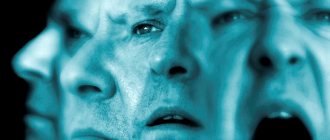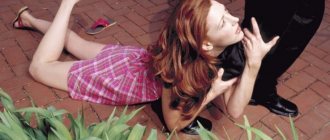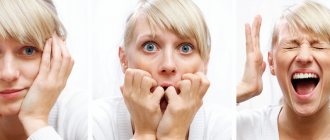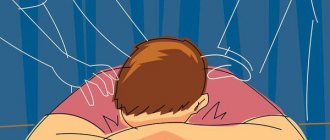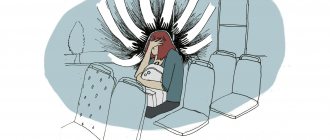Medical information is reliable Checked by Shaidullin Renat Flyurovich
Schizoaffective disorder is an endogenous mental disorder, the symptoms of which simultaneously resemble the symptoms of both schizophrenia and affective psychoses. It is characterized by impaired thinking and unregulated emotions. May include disorganization of speech, hallucinations, and paranoid delusions. The diagnosis of the disease is made based on observation if a person has simultaneously signs of bipolar disorder, depression and schizophrenia, but there are no clear criteria for each of these deviations. The pathology usually manifests itself at a young age and is treated by a psychiatrist.
Causes of schizoaffective disorder
The exact causes of the pathology are unknown, like many other mental disorders, but there are several individual characteristics of the body that increase the likelihood of developing schizoaffective disorder. Most often it is observed in individuals with a hereditary predisposition.
Researchers have identified a risk gene that causes the development of schizophrenia. But under certain conditions, it is in a “dormant state” and begins to manifest itself after exposure to severe stress, severe somatic illness, etc. In addition, the appearance of this gene in the fetus may be due to mutational processes. There is also an assumption of the etiological and pathogenetic similarity of this disease and epilepsy, since in both cases there is a periodicity of manifestations and characteristic changes in the electrical activity of the brain on the EEG.
Provoking factors for the development of schizoaffective disorder can be:
- low social status;
- hunger and poverty;
- hostilities;
- forced migration;
- complete loneliness and lack of help from other people;
- alcohol and drug use.
In the case of the use of psychoactive drugs and alcohol, the possibility of developing this mental disorder increases. At the same time, people with this pathology also often have chemical dependencies, with the help of which they try to get away from their painful sensations, but this only aggravates the process of degradation. To determine what is primary – a mental illness or an addiction to alcohol or drugs, an experienced specialist and monitoring of the patient’s condition in a psychiatric hospital are required.
Dr. Isaev’s clinic has all the conditions for conducting differential diagnosis and providing professional assistance for schizoaffective disorder. For more detailed information, you just need to call the number listed on the website.
Causes
Scientists cannot currently agree on the causes of the disorder. Most scientists adhere to the genetic theory of the development of SAD. It is believed that those people whose relatives were carriers of schizophrenia or affective disorder are “rewarded” with the risk of getting sick.
Another version suggests the presence of a risk gene for schizophrenic conditions. According to the theory, this gene “sleeps” in the body of almost every person, but wakes up under exceptional circumstances. It turns out that everyone has the opportunity to develop recurrent schizophrenia. The theory only assumes the development of this scenario: there is no clear evidence in this regard.
A connection between the disease and epilepsy has been established. The assumption is confirmed by the results of echoencephalography. In patients with SAD, increased excitability of the same brain regions was observed as in schizophrenia.
An interesting fact has been noticed: people born in late winter - early spring suffer more from the disease.
Negative environmental factors play a large role in the formation of the disorder. Firstly, it has been established that the disease more often affects lonely people who lack outside support. Secondly, the cause is negative events in a person’s life. This category includes poverty, forced change of residence, psychological trauma, chronic, acute stress.
The interdependence between drug and alcohol addiction and schizoaffective disorder is established. Both pathological conditions can provoke each other. Psychotropic substances and alcohol are excellent stimulants of the ball. However, the tormenting sensations of the disease subside for some time under the influence of psychotropics. In the future, when the effect of alcohol and drugs lowers the level of dopamine, the condition does not improve - it worsens, turning into a deeper form.
Physiological factors are also considered as a cause: viral infections, head injuries, hormonal surges.
Types of Schizoaffective Disorder
Depending on the predominance of a particular clinical picture, the following types of shazoaffective disorder are distinguished:
- manic;
- depressive;
- mixed;
- unknown etiology;
- other types of deviation.
The manic type is difficult, and the prognosis is often unfavorable. Such a person poses a danger during an exacerbation period and requires placement in a psychiatric ward. The depressive form of the disorder resembles prolonged or moderate clinical depression. In the mixed type, signs of schizophrenia and a picture of affective disorders are noted. Symptoms of schizoaffective disorder begin with the pre-manifest stage, then the attack itself is observed, and after that a remission of varying duration occurs. On average, the acute period lasts for 6-8 months.
Any form of schizoaffective disorder requires timely help. If such a problem has arisen in your family, call us and an experienced specialist will tell you what can be done in this case.
Symptoms and signs of schizoaffective psychosis
Symptoms of the disease are varied and usually consist of sudden mood swings, hallucinations, and absent-mindedness. Symptoms can be pronounced or quite mild.
There are three forms of manifestation of the disease:
- In the first case, the symptoms of the disease appear when the mood is high. The patient can express thoughts about greatness, superpowers against the backdrop of fuss or fun.
- The second type is depressive in nature. Here, hypochondriacal ideas, thoughts of self-destruction, feelings of guilt, and so on are added to the lack of mood.
- The third, mixed, type is characterized by a change in mood from a feeling of universal happiness to sadness and complete apathy.
Schizoaffective disorder: symptoms
The first symptoms of this mental disorder are usually observed in adults; children, as a rule, do not suffer from it; the pathology is more often described in women. The first attacks, reminiscent of schizophrenia, alternate with affective manifestations and delusions, while relatively preserved social adaptation and ability to work are observed. Sometimes, at first, emotional disturbances come first, which are replaced by delusions and hallucinations. In some cases, deviations occur simultaneously, and then diagnosis does not cause difficulties.
Schizoaffective disorder refers to transient conditions of an endogenous nature. In this case, disturbances of the emotional type prevail over productive symptoms. The attack is characterized by significant polymorphism of manifestations; its structure includes depressive-paranoid and manic-paranoid types of attack.
The main symptom accompanying schizoaffective disorder is frequent changes in the patient's mood. This happens suddenly, unpredictably and cannot be controlled. After that, attention deficit disorder, hallucinations, and a person’s ability to control their behavior are added to the overall picture. He ceases to understand the difference between reality and his own far-fetched illusions; imagination begins to play the leading role. The disease can manifest itself as pronounced deviations that become noticeable to everyone around, or it can occur in an erased form, when the changes are visible only to those close to you. Typically, schizoaffective disorder is accompanied by the following symptoms:
- depression;
- depression;
- loss of appetite;
- change in body weight;
- addiction to drinking alcohol;
- disturbance of the alternation of sleep and wakefulness;
- lack of interest in what is happening around;
- weakness, loss of strength;
- self-flagellation, decreased self-esteem;
- decreased concentration;
- lack of control over thoughts and actions;
- inadequate emotional reaction;
- suicidal tendencies, thoughts of death;
- strange behavior.
A person with schizoaffective disorder suffers from hallucinations, stops performing simple hygiene procedures, and develops obsessive ideas. The acceleration of thought processes leads to the fact that speech becomes fast, words seem to be layered on top of each other, endings are swallowed.
When the first signs of schizoaffective disorder appear in a loved one, you should not expect the problem to solve itself. The sooner you seek help, the more effective the therapy will be.
In depressive-paranoid types of attacks, the pathology manifests itself in the form of decreased mood and delusions of self-deprecation, ideas of poisoning, destruction, the presence of a fatal incurable disease, and sinfulness. A person suffers from apathy, depression, insomnia. A severe form of the seizure is manifested by depressive oneiroid or stupor. Depressive attacks, if left untreated, can result in the development of addiction or attempted suicide.
The manic form of the attack is accompanied by a decreased need for sleep, unbridled joy, agitation that does not correspond to the situation, and ideas of one’s own importance and greatness. With severe psychosis, delusions of fantastic content and other productive schizophrenia-like symptoms appear. There is a decrease in concentration, increased energy, and inappropriate social behavior due to disinhibition of the nervous system. Clinical manifestations do not appear immediately, but gradually increase in intensity. Sometimes there are ideas of persecution and pronounced aggressiveness, in which a person begins to pose a danger to those around him.
Mixed states represent frequent fluctuations from hypomania and mania to depression. These affects are accompanied by delusions, which contain the theme of the struggle between good and evil with auditory hallucinations of a positive and negative type. They are contradictory and often mutually exclusive in meaning. The mixed type of schizoaffective disorder manifests itself in the form of alternating depressive-paranoid and manic-paranoid disorders (happiness-fear psychosis).
During the period of remission, a person does not have an emotional-volitional defect; after an acute attack, residual symptoms of schizophrenia or affective deviations persist for some time.
V.I. Dikaya, A.N. Korenev, P.V. Bologov.
Moscow, Russia.
The general principle of identifying schizoaffective psychosis (SAP), based on the mandatory combination in its picture (sequential or simultaneous) of affective disorders with signs of schizophrenia, mainly represented by symptoms of rank I according to K. Schneider, obviously determines the complexity and controversy of an unambiguous syndromic and nosological assessment of this disease . The question of which disorders - affective or delusional - are leading in determining the prognosis and clinical essence of schizoaffective psychosis is still being discussed. The legitimacy of distinguishing SHAP or, conversely, identifying it with affective psychosis and paroxysmal schizophrenia is also being debated. A number of authors support the position on the advisability of a narrower interpretation of the group of schizoaffective psychoses. Moreover, in the ICD-10 classification, the syndromic presentation of schizoaffective psychosis also does not determine its nosographic essence.
The different nature of the outcomes of schizoaffective psychoses, according to modern literature, cannot always be explained by the dependence on the characteristics of typological varieties of affective disorders, their leading pole and dominant polarity during the course of psychosis (3,4,8). Therefore, the need to search for the most significant clinical and clinical-biological parameters that influence the nosological assessment of schizoaffective psychosis and its prognosis has again become obvious.
Identification of affect-dominant and schizodominant forms of schizoaffective psychosis is one of the approaches to clarifying the relationship of schizoaffective psychosis with a group of schizophrenic and affective diseases and clarifying their mutual position in the taxonomy of endogenous psychoses. This clinical division of schizoaffective psychosis is reflected in the American Research Diagnostic Classification (RDC) (9), developed by R. Spitzer, J. Endicott, E. Robbins in 1978, and then modified by other researchers based on the parameter of different quantitative relationships between affective and schizophrenic symptoms both in the structure of a schizoaffective episode and in the course of the disease (2,5,7). The affect-dominant form of schizoaffective psychosis is understood as a disease with a predominance of affective disorders not only in the course of the disease, but also in the picture of the schizoaffective episode itself, provided that schizophrenic symptoms with persistent affective disorders have been present for at least one week. The schizodominant form of SHAP is understood as a disease with a more obvious presentation of schizophrenic symptoms and their relatively longer duration in the disease picture, provided there are no affective disorders for at least one week with remaining schizophrenic symptoms.
However, this division of SHAP does not fully take into account the clinical uniqueness of the structure and dynamics of a schizoaffective attack, but uses only formal signs of existing mental disorders without their psychopathological assessment, which makes it difficult to interpret them in terms of subsequent influence on the course and outcome. We believe that one of the most promising approaches is the search for adequate approaches to the psychopathological and clinical analysis of schizoaffective disorders and the determination of criteria for their prognostic significance.
We carried out psychopathological and clinical differentiation of schizoaffective psychosis, diagnosed in accordance with ICD-10 criteria. According to these criteria, the severity of affective disorders in the picture of a schizoaffective attack corresponded to moderate or severe depression or mania, and non-affective (schizophrenic) disorders included signs “a-d” from the list of mandatory criteria for diagnosing schizophrenia. The selection of patients was carried out taking into account the presence of at least 3 phases/attacks, including the manifest state. Statistical processing of the material and assessment of the reliability of the compared values was carried out using the x test and Student's test on an IBM-PC 486 PC using the Pearson and SPSS 6.1 programs in the laboratory of mathematical analysis of the Scientific Center for Scientific Research of the Russian Academy of Medical Sciences (head - S.A. Sudakov, performer - A.M. .Amosova).
153 patients were examined using clinical-psychopathological and clinical-follow-up methods. Of these, 76 patients (71 women, 5 men) had an affect-dominant form of SHAP, and 77 patients (70 women, 7 men) had a schizodominant form. In all cases, the disease manifested itself in middle age (at 26.7 years and 27.5 years, respectively). The follow-up period varied from 2 to 35 years and averaged 7.9 years and 6.5 years, respectively.
Clinical and psychopathological differentiation of manifest schizoaffective states of the affect-dominant form of schizoaffective psychosis revealed its clinical heterogeneity. The unifying properties of the structure of a manifest schizoaffective attack were the clear predominance of affective disorders over delusional ones (their average ratio is 20:1), as well as the consistent alternation in the dynamics of the schizoaffective state of the following stages: 1) initial affective disorders; 2) affective delirium; 3) actual delusional (non-affective) disorders and 4) final affective disorders at the stage of reverse development of the attack. It was found that in its formation, each schizoaffective state corresponds to characteristics of these stages that differ in duration and degree of completeness of psychopathological symptoms. That is, in the stereotype of the development of psychosis, it was possible to trace, with a certain degree of convention, a sequential change of independent syndromes at each of the stages - affective, affective delirium and non-affective delirium.
The clinical study showed that despite the obvious predominance of affective disorders in the picture of schizoaffective psychosis, the most preferable principle was its division according to the characteristics of delusional disorders and the mechanisms of delusion formation, which largely reflected information about the characteristics of the course of the disease. At the same time, neither the typological features nor the polarity of affective disorders had a leading prognostic value in determining the prognosis of the disease as a whole.
In accordance with this principle of separation, 3 types of affect-dominant schizoaffective states were identified, in which delusional disorders were determined by a picture of acute sensory delirium in the form of acute delirium of perception, acute visual-figurative delirium of the imagination and acute intellectual delirium of the imagination (according to S.Yu. Tsirkin, 1991) ( 1). Each type of delusion was associated with a preferred pattern of depression or mania.
Type I affect-dominant states were determined by delusions of perception (31 patients, 40.8%), developed more often after psychogenic episodes and most often against the background of depressive affect (84.4%), lasting from 1 to 3 months and, as a rule, after depression, more often apatho -adynamic in nature (48.4%), less often after classical melancholic depressions (12.9%) and even less often after cheerful manias (9.6%). The formation of delusions of perception was preceded by the stage of “isolated” and the most persistent affective delusions ( lasting 1-2 weeks), which was most pronounced on the eve of a delusional mood, when the ideas of sinfulness and guilt acquired a global character. The succeeding picture of transient delusion of perception most often corresponded to the delusion of staging - 67.7%, in 19.4% it was limited to a delusional mood and only in 12.9% - delusion of symbolic meaning. At the height of psychosis, delusional affect itself dominated in the form of confusion or anxious tension with a persecutory connotation of the content of experiences. The exit from psychosis was critical, with the exit into depression of the same type and complete criticism of the period of illness. After the reduction of delusional disorders themselves, manifestations of depressive delusions again came to the fore, which were reduced within 2-3 weeks, and affective disorders persisted for another 1.5-3 months. In general, the duration of the schizoaffective state was 7.5 months and it was shortest in the subtype with delusional mood (5.6 months), and longer with delusions of symbolic meaning (10.5 months).
The subsequent course of the disease when manifesting type I affect-dominant schizoaffective state was close to phase, with a relatively low frequency of phases (0.61 per year) with relatively long remissions (24.4 months), and the frequency of affective and schizoaffective phases was the same (0.3 and 0.31). In the dynamics of the disease, the majority of patients had affective disorders of a bipolar nature, but only here the unipolar depressive type of affect was most represented (40.6%). In 65.6% of patients, after 3-5 years the disease passed to a purely affective level or proceeded with repeated attacks of the “cliché” type. In remissions, transient features of asthenia were noted, the premorbid personality structure was preserved, and indicators of social and labor adaptation remained high.
Type II affect-dominant states (32 patients, 42.1%) were characterized by visual-figurative delirium of the imagination, which did not have a specific interpretation in its content and developed both autochthonously and after somatogeny and mainly against the background of manic affect (in 79.2% of cases ), which was represented in approximately equal proportions by psychopathic-like and classical manias and manias with ideational confusion. Unlike type I affect-dominant states, affective delusions appeared here not only as an independent stage of the schizoaffective state, but often remained in parallel with the development of non-affective delusional disorders. Only at the height of the psychotic state were its manifestations fragmented and supplanted by actual delusional disorders of the type of “delusional ideas” with a simultaneous decrease in the severity of affective delusions and an increase in the delusional affect of anxiety and confusion. The simultaneous coexistence of affective and non-affective delusions created a pronounced syndromic polymorphism of delusional disorders in the picture of a schizoaffective attack and a rapid transition to onirism. The recovery from psychosis in a schizoaffective attack was closer to critical; at the stage of reverse development of the schizoaffective state, manic affect with manic delusional disorders again dominated. Once the affect-dominant state of type II had passed, a somewhat formal criticism of the psychosis developed. Its average duration was 7.9 months.
The further course of schizoaffective psychosis here was also relatively favorable, as if intermediate between phase dynamics and close to a recurrent paroxysmal course. Subsequent attacks developed more often autochthonously, according to the “cliché” type. In 61.5% of patients, the disease was regressive in nature with a transition to a purely affective level of disorders. The average frequency of attacks per year here was higher than in type I conditions (0.9), the duration of remissions was shorter (18.9 months). The ratio of attacks of the affective and schizoaffective structure was almost equal (0.45 and 0.43, respectively) . In the dynamics of the disease as a whole, the bipolar type of affective disorders with a predominance of manic disorders clearly dominated. In remissions, personality changes were noticeable with a clear sharpening of pre-manifest hysteroschizoid characteristics, traits of rationalism, and mental rigidity without a subsequent deepening of personality characteristics as the period of follow-up increased. There was a slight decrease in professional level (in 1/3 of the patients), but in general all patients remained able to work.
Type III affect-dominant states were distinguished by the development in the picture of an attack of intellectual delirium of the imagination (13 patients, 17.1%). Its occurrence was only autochthonous and mainly against the background of manic affect, usually of a psychopathic nature. In the dynamics of the attack, the stage of full-blown manic disorders was followed by the stage of atypical manic delirium, with elements of ideational development, like fiction. With the further development of the attack, against the background of a pathologically enhanced ideational component of the imagination, the formation of delusional disorders proper took place according to the type of intuitive delusional “guess”. At the height of delusional psychosis, inventions of paraphrenic content prevailed, signs of dreaminess were absent. The reduction of delusional disorders took place lytically and ended with a return to manic delusions and then to “purely” manic disorders within 3-5 months. The duration of manifest affect-dominant state type III averaged 6.7 months.
The subsequent dynamics of the disease were paroxysmal and progressive in nature. With a total frequency of attacks of 0.8 per year, their average duration was twice as long as in types I and II of conditions, respectively, and remissions were shorter (up to 9.3 months). In terms of frequency, schizoaffective attacks prevailed over affective ones in the dynamics of the disease ( 0.49 and 0.31, respectively). Characteristic was the continuum type of course of affective disorders. In 100% of patients, bipolar affect occurred with a clear predominance of the manic pole of affect, with the frequent subsequent formation of unipolar manic disorders. The transition to the affective level was relatively rare here. In remissions, negative personality changes were clearly detected in the form of an increase in emotional deficiency, decreased productivity, and thinking disorders. Here there were lower rates of social and labor adaptation than with types I and II of affect-dominant states.
Thus, the clinical heterogeneity of diseases united by the concept of an affect-dominant form of schizoaffective psychosis has been revealed. A reliable relationship was found between the identified typological variants of schizoaffective states and the types of further course of the disease. They did not find a definite relationship with the leading polarity of affect in the dynamics of the disease: in all types of the course of affect-dominant schizoaffective psychosis, bipolar affect was dominant (76.5%), which confirms the validity of using other principles of their clinical separation.
Clinical and psychopathological differentiation within the schizodominant form of schizoaffective psychosis also revealed the heterogeneity of its manifestations and the dynamics at different stages of the formation of the schizoaffective state. In contrast to the affect-dominant form in the picture of a schizoaffective attack, the stage of delusional disorders proper here was longer, from 1.5 months to 4.5 months, and the ratio of affective and non-affective delusional disorders was 1.5:1. The sequential change in the stages of formation of the schizoaffective state was unclear, the manifestations of each of them were often layered on top of each other. Manifestations of affective delusions were formed, as a rule, with non-affective delusions and coexisted in the picture of a schizoaffective state. Psychopathological manifestations of delusional disorders themselves always reached a paranoid level and differed from affect-dominant ones in that they necessarily included mixed mechanisms of their formation with the participation of both acute sensory and ideational forms of trouble.
Depending on the prevailing mechanisms of delusion formation in the structure of delusional (paranoid) disorders, 3 types of schizodominant states are identified - which developed as paranoid psychoses in the picture of acute delusions of perception with elements of interpretation (Type I), in the structure of visual-figurative delusions of imagination with elements of interpretation (II type) and based on acute interpretive delusion (type III). In general, there was no reliable relationship between these types of schizoaffective states with clinical, typological manifestations, the type of polarity in the dynamics of the disease and the pole of affect in the attack. Regardless of the types of course and schizodominant schizoaffective psychosis, bipolar affect was dominant in the dynamics of the disease (in 96% of cases).
Type I schizodominant conditions (23 patients, 30%) were characterized by the development of paranoid syndrome in the structure of acute delusions of perception with elements of interpretation. It was formed autochthonously and only in 30.4% after psychogenicity in most cases (87%) against the background of previous asthenic-adynamic depressions for 1-2.5 months. On the eve of the development of distress psychosis itself, individual ideas of relationship with unstable persecutory content appeared in the structure of depression. There was no independent stage of affective delusion observed here; only some of its manifestations were layered on the delusional manifestations of the subsequent stage of delusional disorders proper. In their picture, circular affect was completely replaced by distress, with paranoid symptoms and the development in its structure of manifestations of acute Kandinsky-Clerambault syndrome, closely associated in its manifestations with acute sensory delirium of perception, but with an attempt at a delusional interpretation of facts, events and, less often, with a fantastic modification delirium and psychotic affect. The duration of the stage of delusional disorders itself was 1.5 months. The way out of psychosis was lytic. With the reverse dynamics of the disorders, the same circular affect that took place at the initial stages of the attack began to dominate again, its duration did not exceed 3 weeks. The total duration of the entire type I schizodominant state averaged 4.3 months. A fairly complete criticism was formed during the period of illness.
The further course of the disease was intermediate in nature between the phase and recurrent course with a relatively low overall frequency of attacks (0.64) and the highest duration of remissions (16.3 months). The frequency of affective and schizoaffective episodes in the dynamics of the disease varied slightly (0.29 and 0.35, respectively). In more than half of the cases, a transition of the disease to the affective level was observed. Bipolar affective disorders dominated the dynamics of the disease. The personal make-up of patients as the disease progressed underwent only minor dynamics in the form of a sharpening of the asthenic premorbid personal radical. The level of social and labor adaptation did not change.
Type II schizodominant conditions (24 patients, 31%) were manifested by the development of paranoid syndrome in the structure of visual-figurative delusions of the imagination with elements of interpretive delusions. It developed more often autochthonously and predominantly against the background of inversion of the pole of circular affect, more often when the previous depressive phase was replaced by a manic one. Therefore, the stage of “purely” affective disorders here did not exceed 5-7 days, and then in the picture of affective disorders, both affective and non-affective delusional disorders formed in parallel with each other and the state became polymorphic. Actually, delusional disorders arose according to the type of “delusional ideas”, “sudden thoughts”, were accompanied by elements of interpretation and reached acute Kandinsky-Clerambault syndrome with transformation into delusional depersonalization of fantastic content, sometimes with elements of oneirism. The duration of the period of non-affective delirium was about 2 months. The recovery from delusional psychosis was lytic with a return to manifestations of affective disorders of the same pole lasting up to 1-2 months. The average duration of this condition was 5.2 months. Formal criticism was formed only during the acute period of the illness. After a manifest schizodominant attack, most patients experienced a clear personality shift with the appearance of noticeable autism and increased signs of emotional deficiency, mental rigidity with regressive syntony.
The course of the disease was defined as paroxysmal-progressive. The overall frequency of attacks here was higher (0.99), and the duration of remissions was shorter (13.8 months). The frequency of affective and schizoaffective episodes was almost equal (0.49 and 0.5). During the course of the disease, a distinctly bipolar type of affect predominated. The transition of the disease to the affective level was quite rare. The structure of repeated attacks during the course of the disease was simplified, but they became more protracted. A decrease in indicators of social and labor adaptation was noted in 41.6%.
Type III schizodominant states (30 patients, 39%) included a paranoid state developing on the basis of acute interpretative delusions. They were formed autochthonously against the background of apatho-adynamic depression in 60% or psychopathic-like mania in 40%. The duration of the stage of purely affective disorders did not exceed 2 weeks. Psychopathological manifestations of the stage of delusional disorders proper arose subacutely with the parallel formation of paranoid disorders and affective delusions, which receded into the background at the height of paranoid psychosis, but during the period of reduction of disorders occupied a dominant position in the picture of the condition. In the structure of a schizodominant attack, the defining factors were Kandinsky-Clerambault syndrome with elements of acute sensory delusion in the form of an undeveloped staging syndrome, isolated false recognitions in combination with circular affect. The duration of the period of delusional disorders itself was on average 2.5 months, and the overall duration of the attack was from 3 to 6 months. During the period of reduction of disorders, a change in the pole of affect to the opposite was often observed, and after the schizoaffective state had passed, almost half of the patients showed residual delusions.
The subsequent dynamics of the disease were defined as fur coat-like with pronounced progression. There was no transition of the disease to the affective level. A protracted course of attacks with a tendency to chronicity was often noted. The overall duration of remissions was lower here (11.2 months), and the frequency of schizoaffective attacks averaged 1.07 per year. Negative personality changes increased after each attack and were expressed in autism, emotional impoverishment, decreased mental productivity with impaired thinking.
Thus, the presented clinical differentiation of manifest schizoaffective states according to the characteristics of non-affective delusions in their picture provides prognostic information for assessing the course of schizoaffective psychosis as a whole and reveals differences in the types of its dynamics (phases, attacks, fur coats) and the degree of its progression. They confirm the clinical heterogeneity of schizoaffective psychosis and allow us to consider it as a nosologically and clinically combined group of disorders united under the general name of schizoaffective psychosis. True or “core” forms include affect-dominant schizoaffective psychoses manifested by delusions of perception (type I affect-dominant states), which do not show progression,
despite schizophrenic delusional manifestations during an attack, they have a phase dynamics of disorders and in terms of prognosis are the most favorable. “Extreme” or intermediate forms of schizoaffective psychosis include affect-dominant forms of schizoaffective psychosis with a picture of visual-figurative delirium of the imagination in a schizoaffective attack (type II affect-dominant states). Edge forms also include schizodominant forms of schizoaffective psychosis, which manifest themselves as acute paranoid syndrome in the structure of delusions of perception with elements of interpretation in the picture of the attack (type I schizodominant state). Both of these varieties have a phase-recurrent nature of the course of the disease, do not show signs of progression and also have a relatively favorable prognosis. In progressive varieties of schizoaffective psychosis, in which the formation of delusional disorders in the picture of schizoaffective states occurs with the participation of ideational forms of delirium - type III affect-dominant states with a picture of intellectual delirium of the imagination and types II and III of schizodominant states, characterized by paranoid syndrome in the structure of visual-figurative delusions with elements interpretation or in the structure of acute interpretive delusion. The course of the disease in these cases corresponded to the schizoaffective variant of fur coat-like schizophrenia. The established clinical and nosological heterogeneity of schizoaffective psychoses is confirmed by the results of neurophysiological, biochemical and experimental psychological studies conducted in parallel with the clinical analysis of schizoaffective psychoses.
LITERATURE
1. Tsirkin S.Yu. Differential diagnosis of conditions with delusions of imagination // Current issues in psychiatry and narcology: Abstracts of the IV Congress of Psychiatrists and Narcologists of the Perm Region - Perm, 1991-pp. 15-16
2.Angst J. Verlauf und Ausgang affektiver und schizo-affektiver Erkrankungen in: Huber G. ed. Zyklothymie-offene Fragen. Artl. Gessprach-1986-Bd.41-s.41-82
3.Black DW, Winocur G., Nasrallah A., Brewin A. Psychotic symptoms and age of onset in affective disorder // Psychopathology-1992- v.25 -N-1- p.19-22.
4. Coryell W., Keller M., Lavori Ph., Endicott J. Affective Syndromes, Psychotic Features and Prognosis//Arch.gen.psychiatry- 1990 - v.47- N-6- p.651-662
5.Marneros A., Deister A., Rohde A., Junemann H and Fimers R. Long-Term Course of Schizoaffective Disorders//Eur.Arch.Psychiatry Neurol.Sci- 1988- v.237 -p.264-275
7.Marneros A., Deister A., Rohde A. The Concept of Distinct but Voluminous Groups of Bipolar and Unipolar Diseases // Eur. Arch. Psychiatry Clin. Neurosci- 1990 - v.240 - p.77-84
8.Mc.Glashan TH,Williams PV Predicting Outcome in Schizoaffective Psychosis// J.Nerv.Ment.Dis.-1990-v.178-N-8-p.518-520
9. Spitzer RL, Endicott J., Robins E. Research Diagnostic Criteria for a Selected Group of Functional Disorders (RDC) -ed.2, New York- Biometrics Research Division, New York Psychiatric Institute-1978
Signs of affective disorders
Clinical symptoms of schizoaffective disorder include mood disturbances and schizophrenic features. The degree of their expression is approximately the same, while they alternate or are observed simultaneously. Deviations of an emotional nature are:
- manic;
- depressed;
- agitated.
During mania, a person feels a surge of energy and strength, is always in a great mood, even to the point of euphoria, and is constantly busy doing something. His thinking speeds up greatly and he has difficulty trying to concentrate on a specific job, and problems with concentration arise. His speech becomes fast and incomprehensible due to constant jumping from one topic to another. The patient feels able to “move mountains.”
One of the variants of mania is increased irritability and anger. The person becomes aggressive, behaves rudely with other people, is rude, interrupts, and counteracts. Often this state accompanies the delirium of saving humanity from an alien invasion or another fictitious global problem of the world level.
When depressed, the patient loses his appetite, and sometimes he does not even have the strength to get out of bed. The pace of thinking processes slows down, a person feels melancholy and engages in self-flagellation, and does not find any sources of joy in life. If help is not provided in time, then during this period the likelihood of suicide greatly increases. A subtype of depression is considered to be agitation, when the patient’s sharply depressed mood is masked by active and unproductive activity, which is chaotic in nature.
Signs of schizophrenia
Typical signs of schizophrenia in schizoaffective disorder include:
- delusional ideas;
- hallucinations.
The patient's delirium usually corresponds to his mood. With depression, ideas of one's own worthlessness and uselessness arise. Sometimes hatred appears towards family and friends, as well as towards humanity as a whole. If mania develops, the patient insists on his greatness, considers himself perfect, is confident in his own superpowers, and points to the mission entrusted to him to save the world.
Hallucinations in schizoaffective disorder are usually auditory, but can also be visual or tactile. During an exacerbation, a person sees something that is not really there or hears non-existent voices and sounds. The situation is greatly complicated by concomitant catatonia, usually in the form of stupor.
Differential diagnosis of schizoaffective disorder
Since schizoaffective disorder includes symptoms of schizophrenia and manic-depressive psychosis, it is important to distinguish between these diseases. Schizophrenia is a severe chronic mental illness in which remission is difficult to achieve and complete recovery is impossible. It differs from schizoaffective disorder in the absence of a residual defect in the period after an exacerbation. In this case, we mean passivity, apathy, desocialization, flattening of emotions.
The bipolar state is accompanied by mood swings, but does not lead to a decrease in socialization. Its similarities with schizoaffective disorder include the following symptoms:
- episodic manifestation;
- being in a depressed or highly excited state;
- severe anxiety.
The difference is that with schizoaffective disorder, productive symptoms are present simultaneously with affective deviations. Therefore, it is impossible to immediately diagnose this pathology even with knowledge and experience. This is especially difficult if the disease does not immediately develop with signs of schizophrenia and affect during the next exacerbation. It is possible to verify the presence of the disease only after some time, and this requires constant medical supervision.
Experts' forecasts
The main difference between schizophrenia and recurrent schizophrenia is the consequences of recovery from psychosis. In the second case, subject to timely and correct treatment, the patient does not experience a residual schizophrenic defect after an exacerbation. This means that his behavior will lack such manifestations as passivity, apathy, loss of social connections, irreversible emotional flattening (lack of reaction to what is happening).
As a rule, after therapy, the patient may be left with short-term and insignificant phenomena, such as increased fatigue, a feeling of inadequacy, etc. After a short time, they disappear, and the person has the opportunity to return to his previous life.
Despite the favorable prognosis, this does not make this disease easier or less significant. It is strictly contraindicated to refuse treatment or do it yourself. After a course of therapy, the patient must follow the doctor's instructions. At the same time, the patient is prescribed not only drugs that relieve and prevent possible recurrences of schizophrenic symptoms. During this period, the patient also needs to take mood-stabilizing medications.
Schizoaffective disorder: drug treatment
Therapy for schizoaffective disorder at Dr. Isaev’s clinic includes the use of medications to relieve symptoms and psychotherapy. If the patient shows severe aggression during an attack, he is hospitalized until a stable condition is achieved. Taking medications is the main form of assistance for this disease, while working with a psychologist is considered no less important, but auxiliary.
To treat and eliminate negative symptoms, the following are usually prescribed:
- antipsychotics, they eliminate delusions, hallucinations and other symptoms of psychosis;
- anxiolytics for sleep disturbances and severe anxiety;
- antidepressants, which stop low mood, apathy, a feeling of uselessness, the desire for one’s own death, encourage action;
- mood stabilizers to normalize mood in case of low mood or manic disorder;
- sleeping pills that help normalize a good night's rest.
Acute psychosis with this deviation is usually treated with a combination of two or more medications. But it is best for the doctor to select a dose with constant observation, and therefore the person needs to stay in the hospital for some time. After achieving remission, the patient begins outpatient treatment with periodic visits to a psychiatrist. He comes to see him or a specialist is called to his home for a routine inspection.
In our clinic, only proven, certified drugs are used to treat schizoaffective disorder. They give the desired result and at the same time have minimal side effects.
If a person has schizoaffective disorder and dependence on alcohol and psychotropic drugs, then in this case a narcologist is involved in the therapy process, since chemical addictions greatly aggravate the condition and reduce the effectiveness of treatment.
General understanding of schizophrenia
Schizophrenia is a mental illness that can have severe forms and is characterized by disorders of the emotional area of a person: disturbances in thought processes, perception, behavior, inability to communicate in society. Most often, schizophrenic symptoms manifest themselves in the age period from 14 to 35 years.
The presence of schizophrenia leads to significant disabilities: the patient does not have the opportunity to receive an education or fully engage in work. It is important to note that this disease cannot be completely cured. However, the severity of its course can be controlled by a psychiatrist. By prescribing the necessary medications in a timely manner, using psychosocial support, the doctor has the opportunity to stop or minimize the manifestation of symptoms.
Symptoms
Diagnosing schizophrenia, especially at an early stage, can be very difficult. This is due to the fact that many of the signs that characterize this disease may indicate other mental disorders. In this case, the doctor sets a period of observation of the patient, during which he conducts a full diagnosis of his condition.
The main symptoms that may indicate the presence of such a pathology are the following:
- auditory, visual or tactile hallucinations appear. The patient begins to see, hear, feel what is not happening in reality;
- delusional states - the patient builds false beliefs for himself that are not shared by others. At the same time, schizophrenics are almost always very suspicious and distrustful of people;
- behavior takes on the features of inappropriate - the patient is disorganized, may forget about the rules of hygiene, appearance, and normal physical sensations are dulled. This may be accompanied by aimless walking, muttering, etc. The mood may change dramatically;
- speech becomes slurred and incoherent. A schizophrenic often independently invents his own words (sentences), giving them a special meaning that is understandable to him alone;
- emotional disturbances are clearly noticeable - apathy, indifference to what is happening, facial expressions, gestures may be absent or, conversely, become too active;
- a person creates his own inner world, withdraws into himself, and practically does not communicate with others.
Diagnostics
Correct, competent diagnosis of mental illness is the beginning of the path to its successful treatment. Due to the fact that it is extremely difficult to determine schizophrenia, especially at the first stage of its development, specialists are as consistent and attentive as possible at this stage.
The doctor regularly communicates with the patient, monitors the dynamics of the development of symptoms, their modification, etc. In addition, the following clinical studies are carried out:
- the patient’s immune status is determined;
- a general and biochemical blood test is performed;
- a hormonal profile is formed;
- additional tests are prescribed to rule out organic brain diseases;
- a general therapeutic and neurological examination is carried out;
- a rapid test is being compiled to determine schizophrenia.
In psychiatric practice, special diagnostic criteria are also known. The presence of at least one of them, and observation of it for 30 days, provides grounds for a more in-depth diagnosis of the disease. Among these criteria are:
- the presence of hallucinations (visions);
- delusions of perception (erroneous judgments about something, paranoia);
- echo of thoughts (voices in the patient’s head);
- associativity (a person avoids communication).
Causes of the disease, its prevention and treatment
Studies of schizophrenia as a mental illness have not found a single factor that could provoke its occurrence. Scientists have come to the conclusion that this mental disorder can occur when the body is exposed to various factors: genetic predisposition, psychosocial circumstances, physical and psychological exhaustion of a person, etc.
Preventive methods to prevent the occurrence of schizophrenia are especially necessary if a person has “blood” relatives with this disease. Prevention consists of regular counseling, testing and, if necessary, supportive care.
Treatment for schizophrenia can be outpatient or inpatient. The second treatment option is necessary in case of acute attacks of the disease, frequent and prolonged relapses. Patients, depending on the severity of the disease, are prescribed antipsychotic drugs of different categories. They are determined exclusively by a specialist after examining the patient.
Application of psychotherapy
Psychotherapy for patients with such a diagnosis is an auxiliary method of providing assistance; it accelerates the effect that can be achieved by precise selection of medications, consolidates the result, prolongs remission, and adapts the person to a society of healthy people. Talk therapy is often used for schizoaffective disorder. It allows you to better understand your condition, understand your own feelings and reduce their influence, identify negative attitudes that provoke destructive behavior, and replace them with constructive thoughts and actions. For this purpose, cognitive-behavioral techniques are used for individual lessons and work in groups. If the cause of the disease is psychotrauma at a young age, psychodynamic therapy is used.
If the patient is unable to express all his problems, art therapy is of great help. Taking part in art, music, or dance can help you express yourself and cope with current triggers for your attacks. Family therapy plays a leading role in the treatment of schizoaffective disorder, which allows one to influence the home environment. Thanks to the participation of loved ones in the treatment process, they can understand:
- the feelings that the patient experiences;
- what actions on their part help or hinder recovery;
- what needs to be done to make positive changes.
Many relatives behave incorrectly towards a mentally ill person. With their hypertrophied care, they cause or strengthen his feeling of inferiority. Understanding his problem, but at the same time constantly recognizing himself as weak and incompetent, the patient only aggravates his difficult situation. Thanks to family psychotherapy, a person understands how his condition and signs of the disease can affect those who live nearby. After treatment, all family members begin to act together, directing their efforts to eliminate existing difficulties and problems, and work on a strategy to prevent the next exacerbation of the pathology.
A person who has been diagnosed with schizoaffective disorder, if he contacts Dr. Isaev’s clinic in a timely manner, has the opportunity to completely get rid of the manifestations of the disease. Qualified specialists help a person with this diagnosis reduce the number of attacks and increase the time of remission for a long time.
Psychotherapeutic techniques aim to remove not only causative factors, but also reduce the likelihood of stressful effects. Work with a specialist begins after the acute attack has stopped, otherwise the doctor will not be able to achieve full contact and awareness of the problem. In general, the prognosis for this disease is favorable, but the outcome depends on the timeliness of the start of treatment and the characteristics of affective and schizophrenic manifestations.
The use of psychotherapy significantly increases the effectiveness of drug treatment. The specialist’s job is to detect hidden factors that provoke attacks, eliminate them or reduce their impact. A person is aware of the reasons for the development of deviations and understands their destructiveness. Family psychotherapy also plays a significant role, thanks to which mutual understanding between the patient and close relatives improves.
Questions and answers
Can schizoaffective disorder be completely cured?
With a mild form of the pathology, stable remission can be achieved for many years. Properly selected therapy can stop their manifestations even with severe attacks and preserve the person’s ability to work. In general, the prognosis in each specific case is individual and depends on many factors.
Is it possible to identify schizoaffective disorder in a loved one?
The symptoms of this disease are very similar to other mental disorders, so only an experienced doctor can make a diagnosis. To do this, it is best to hospitalize the patient and observe him over time.



